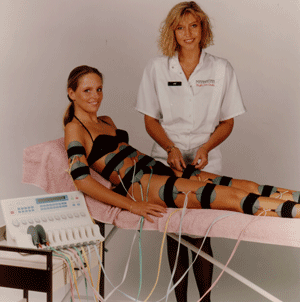ESTIM for Muscle Contraction
Electrical stimulation applied between 100-600 microseconds provides enough stimulation to create an action potential within the muscle fibers (causing a contraction). This can be used to restore force generation, reduce muscle inhibition, treatment for osteoarthritis and rheumatoid arthritis, maintain muscle health in peripheral nerve injuries, Bell's Palsy, reduce or prevent shoulder subluxation, facilitate active contraction following CVA, improve bladder control in patients with stressor urge incontinence, and to improve sensation in patients post CVA or other neurological impairments.
Contraindications
Stimulation where active motion is contraindicated (jt fusion, sutured tendons, sutured nerves, unfixated fracture); pacemaker or implanted stimulator; stimulation directly over superficial metal; active bleeding; malignancies; cognitive impairments or disorientation
Precautions
Pregnancy, long-term steroid use, or over the carotid sinus
How to do it
Position the patient in a comfortable posture with the target tissue exposed. Use a dynamometer to determine the maximum voluntary isometric contraction (MVIC). Select Russian, Biphasic, or Premod. Check the area, make sure there aren't any lotions, dirt, or excess hair. Place two electrode pads (or four if using Premod) on the proximal and distal portion of the target muscle. Make sure the pads are on the muscle belly, do not overlap, and are secured prior to turning on the machine. Set the frequency between 35-50 Hz for a tetanic contraction (if this is an option on the given machine). Set phase duration at 300 microseconds (adjusted if patient comfort dictates). Increase the amplitude until desired contraction occurs. Use a ramp if needed to increase patient comfort. Treatment time is 5-20 minutes.
For strengthening, the contraction should be 25-50% of the MVIC, with on-off time of 1 to 5.
For endurance training, the contraction should be more than 50% of the MVIC, with on-off time of 1 to 1.
Parameters for Strength training
Current type: BPC, MFBurst AC
Pulse/cycle duration: 100-600 us; 10 % duty cycle
Current amplitude: >50%MVIC, >10% injured
Ramp: 1-5/1-5
Frequency: 30-50 pps, bps; 2500 Hz AC Carrier freq
On/off: 6-10s/50-120s
Modulation: None
Rx time: 5-20 min
Electrode: 2-4
Parameters for Endurance training
Current type: BPC, MFBurst AC
Pulse/cycle duration: 100-600 us; 50 % duty cycle
Current amplitude: F25-50% MVIC
Ramp: 1-5/1-5
Frequency: 30-50 pps, bps; 2500 Hz AC Carrier freq
On/off: 6-15s/6-15s
Modulation: None
Rx time: 5-20 min
Electrode: 2-4
Keep in mind:
- Decreasing the size of the electrodes increases the density (makes the current more concentrated, which will lead to more intensity and pain from the patient with higher settings)
- Unequal electrodes are used for High Volt to disperse stimulation with a specific polarity
- When electrodes are closer together, the reflex arc for the current is more superficial
- Electrodes are recommended to be more than ½ diameter apart
- Denervated muscle can only be stimulated at >10 milliseconds for the phase duration
- Frequency and pulses per second are synonymous



"Oh don't mind me, just hangin out with my estim..."

Was she just brought back to life?! Frankenstein?!
Pulse duration curve